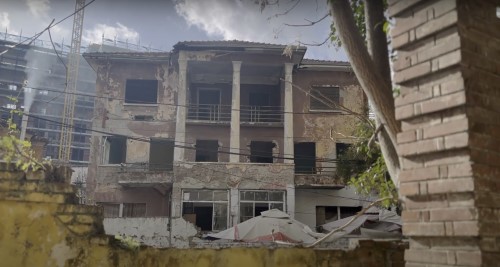10/08/2023
At Kino Lumi, we had the chance to see a selection of films reflecting on the urban realities of Tirana, Kamza, and across Albania while searching the places that are no more. The filmmakers are the participants of the training school: Tirana and Kamza – the planned, the unplanned, and everything in between.
Urban landscapes and architecture seem to be the heaviest and most provoking in Albania, a Trojan horse of sorts that collapses without any announcement. “A Travel Captured” directed by Willie Vogel raises the question of material transportation as a base to build. In Tirana and Kamza, areas affected by urban plans, we come to see how materials get extracted while following a camera being driven in the urban landscape of industrial imagery defined by excavators and concrete. The question remains: Where do we stand when a city undergoes immense transformations?
In “Moving Enclosures” directed by Arba Bekteshi, Irvi Çela, and Nama’a Qudah, we see the aftermath of the urban development in Tirana, as seen in the area of “Pazari i ri” (New Bazaar). There is a certain distinction in the practices carried out by the citizens while the landscape looks detached from the past and present. Presented next was “Radio Tirana”, byAurora Birbilaj, Luna Salamon, Nebih Bushaj, and Viktoriia Grivina, showing the journey of remembrance for an important institution, whose building is left abandoned. We follow the voice of the writer Ardian Vehbiu, explaining the importance of Radio Tirana as a bridge of communication, as an important media asset, and as a geographical point of reference for everyone who lives nearby. We see the empty corridors of Radio Tirana’s buildings displayed while attempting to feel the physical void through memories.
Next in the series of films was “Selvie” directed by Edmond Pergega, Elena Pérez Guembe, Ronald Qema, and Saara Mildeberg telling the story of Selvie and her way of coping in an ever-changing city. Her name coincides with a known location in Tirana, intertwining in this way the symbolic meaning of the tree of selvia, of mourning, and Selvie’s story that just like the tree is still standing and resisting.
Kamza is a new city, but its story relies on affirmations and negations of the places/neighborhoods nearby and the directors Büşra Dilaver, Diana Malaj, Elsa Paja, Holly Dale, and Klodiana Millona explore the city and its surroundings through “The City that was not supposed to be on the map”.
“Would you call yourself a Kombinatas” directed by Agata Kochaniewicz, Dorina Pllumbi, Elina Alatalo, and Sidorela Vatnikaj brings us the story of the protagonists through her memories and remarks regarding the impact the community in Kombinat while reflecting on the several procedures of erasures and relying on remembrance?
In a conversation with Dorina Pllumbi Ph.D. researcher at the Technological University of Delft and one of the directors of this selection of films, she told the origin of this collaboration with Dokufest. In the framework of the European network COST Action Writing Urban Places, Dorina Pllumbi, Diana Malaj (activist at Grupi ATA), and Willie Vogel, architect and researcher at the Technological University of Delft and with the close collaboration of many local activists reflected and explored the themes of what is central and peripheral through many loopholes. Tirana and Kamza focused on trying to understand the culture, the changes, and the aftermaths of urban planning.
The collaboration with Dokufest strengthened the technical process of filmmaking, and Eroll Bilibani together with Blerta Zeqiri mentored the development of these stories.
The communities play a huge role in defining the space resistance and Dorina Pllumbi highlights: “It is important to rethink the city as a collective creation and not a project of higher decision makers or the institutions that support them. These films are a way to show how the role of communities is becoming less impactful, including the decision-making processes that exclude locals. So these films are a way to show how cities hold within them a complex mix of minor forces.
We see the communities voicing the problems and locals holding their position in the city, but the landscape seems to overpower the hope for change. On the other hand, what is central and peripheral is the macro-theme explored through the idea of what constitutes a city, and what are the limits of these ongoing urban changes.
For more info please visit this link:
https://writingurbanplaces.eu/training-school-report-tirana-and-kamza-the-planned-the-unplanned-and-everything-in-between/
By: Blerina Kanxha



